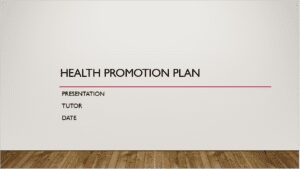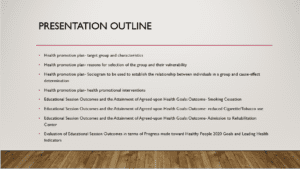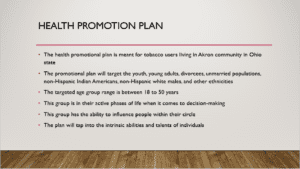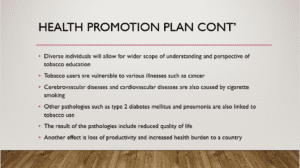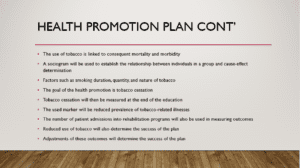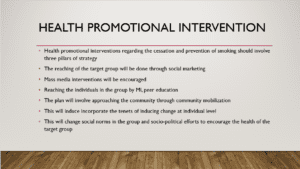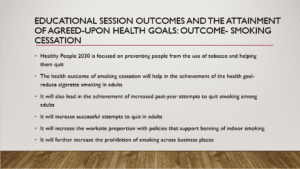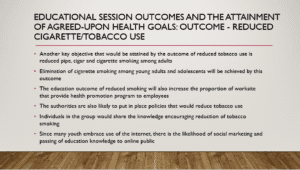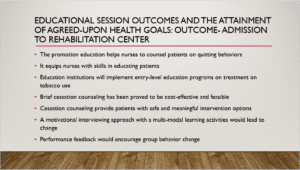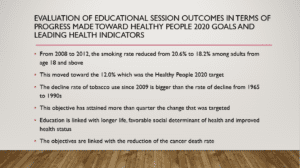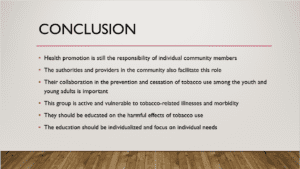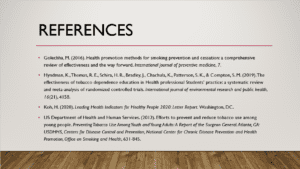Health Promotion Plan
Hello, and welcome to this presentation about the Health Promotion Plan. This health promotion plan is meant for the users of tobacco living in the Akron community in the state of Ohio. This presentation is for all tobacco users from a wide range of individuals with varying age groups, cultures, and educational backgrounds. Get in touch with us at eminencepapers.com. We offer assignment help with high professionalism.
We will start by looking at a health promotion plan describing the target group, the reason for choosing it, and their vulnerability to tobacco-related illnesses. We shall then look at the relationship between individuals in the group and the cause-effect determination of tobacco use. Furthermore, health promotional interventions recommended for the target group will be discussed. To add, we shall evaluate the educational session outcomes and the attainment of agreed-upon health goals: outcome- smoking cessation, educational session outcomes and the attainment of agreed-upon health goals: outcome- reduced cigarette/tobacco use, educational session outcomes and the attainment of agreed-upon health goals: outcome- admission to rehabilitation center, as well as evaluation of educational session outcomes in terms of progress made toward healthy people 2020 goals and leading health indicators.
The target group for the health promotional plan is tobacco users living in the Akron community in Ohio state. This plan will pay specific attention to the youth and middle-aged adults because tobacco use has increased significantly among this group category. Since CDC data on tobacco use reveals that non-Hispanic Indian Americans and non-Hispanic white males have had the highest prevalence of tobacco use among the ethnic groups within the United States, this plan will also include this category. Moreover, research shows that tobacco use is also higher among unmarried and divorcee populations (Jaber et al., 2018). This means that the plan will target tobacco users across various ethnicities within the age range of 18 to 50. This group category is selected for the promotional plan because it mainly entails persons in the active stages of their lives and mostly in decision-making roles or positions. The importance of their selection is because they can influence other people within their circles, thus ensuring that the health promotional strategies are passed to myriads of other people. Moreover, selecting a diverse group of people to educate has the advantage of tapping into individuals’ intrinsic abilities and talents.
Focusing on individuals from diverse backgrounds and cultures leads them to appreciate the perspective of others on this topic and consequently widen their scope of understanding on the subject matter. The health promotion plan will entail education on the fact that tobacco use has been linked heavily with cancer of the lung as well as other cancers. Use over a long time has also been implicated in other lung pathologies, such as chronic obstructive pulmonary disease. Hypertension and consequential cerebrovascular and cardiovascular complications have been attributable to significant mortality rates and are caused or worsened by cigarette smoking. Other pathologies linkable to tobacco use are type 2 diabetes mellitus and pneumonia, among others. The consequence of these pathologies is a reduction in the quality of life, loss of productivity, and an increase in the health burden of a country. Health promotion aims at correcting this by advocating for cessation of use and thus enabling the evasion of these risks.
Tobacco use has been linked to disease development and consequent morbidity and mortality. A sociogram intends to establish the relationships between individuals within a group to enable the determination of cause and effect within the group. In establishing a sociogram for the smoking group listed above, several factors will be included. The duration of smoking is the first factor. This will show the level of predisposition and inform the propensity to develop a disease. Long-time smokers are more vulnerable to diseases than first-timers or short-term users. Quantity is also significant, as the higher the quantity, the greater the propensity to develop a disease. The nature of tobacco use is also essential. Various tobacco types produce different effects on the users. Smokers are at a notably higher risk of developing lung complications compared to those who chew tobacco. All these will inform the development of the sociogram. The health promotional goal is tobacco cessation. This will be measured at the end of the educational process. Markers such as reduced number of cigarettes used per day, total cigarette cessation, reduction in the prevalence of tobacco-related diseases, and the number of patient admissions into rehabilitation programs will be used to measure the outcome. The success of this health promotion exercise will be informed by adjustments to these outcomes (Golechha, 2016). The intended health promotional activity is aimed at health behavior correction by encouraging smoking cessation and prevention.
The health promotion plan has to include strategic interventions that will work for this group category. These interventions have to be three-tiered. Reaching the public group through social marketing and mass media intervention would prove effective, and reaching the group individuals through MI and peer education, and at the same time, approaching the community through community mobilization. Golechha’s (2016) study shows that these strategies have proved effective in inducing smoking prevention and cessation. This is because these methods entail the tenets of inducing change at the level of an individual, a social norm change in the group, and socio-political efforts that promote the population health (Golechha, 2016)—focusing on environmental changes and social attitudinal before individual behavior is necessary. After all, individual behavior is challenging to bring about.
The main focus of Healthy People 2030 is to prevent people from using tobacco products and assist them in quitting. This initiative has many objectives. Among the objectives is reducing cigarette smoking among adults (U.S. Department of Health and Human Services, 2021). Once educational promotion is passed to the target population, they are likely to gain knowledge on the causes and effects of tobacco use, and they are more likely to be empowered to avoid using tobacco or to seek help. This, in turn, helps in the achievement of reduced cigarette smoking among adults. Those who have previously attempted to quit the use of tobacco in the previous years can now get more knowledge and support from the promotional education plan and seek the help that they need because the fact that they attempted to quit means that they understand that it is not suitable for them. Therefore, it is best that they quit. This will lead to the achievement of this goal.
Additionally, this group will feel more empowered to quit and can share their success stories with others, resulting in increased successful attempts to quit. As a result of the promotion, the outcome of smoking cessation will also be reflected in the workplaces where employers will feel the need to ban indoor smoking to help themselves and employees in the journey of smoking cessation. Besides, at the end of the session, many bars, restaurants, and worksites must introduce tobacco ban advertising. According to the U.S. Department of Health and Human Services (2012), one policy that has been shown to minimize youth tobacco use is banning tobacco advertising. For instance, when the U.S. ban on radio and T.V. tobacco advertising was implemented in 1971, more restrictions were included in the Master Settlement Agreement 1988, which addressed tobacco advertising targeting youth and outdoor advertising.
In the U.S., the 2009 enactment of the Family Smoking Prevention and Tobacco Control Act mandated the responsibility to regulate the marketing, manufacture, and distribution of tobacco products (U.S. Department of Health and Human Services, 2012). The 2009 law stipulated that the pack of cigarettes contain more prominent labels that are also pictorial and cover 50% of the back and front of the packs. This is because it was found that small-text health warnings did not have a significant impact on young adults and the youth. Therefore, promotional education would help young adults and youth through warnings and pictures that elicit strong emotional reactions. According to the U.S. Department of Health and Human Services (2012), this strategy has proved to be very effective at discouraging tobacco use, leading to the achievement of the health goal- reduction of tobacco use among youth and young adults. Other legislative efforts have restricted the youth from accessing tobacco products through compliance checks and local and state laws. This helps in eliminating cigarette smoking among the youth. Besides, laws requiring prohibition would help worksites formulate employee health promotion programs. With this education, the authorities will likely put stringent tobacco use measures for manufacturers, distributors, and marketers. In the manner of sharing, the youth are likely to share their experiences and suggest ways of addressing tobacco reduction on the Internet platform.
According to Hyndman et al. (2019) research study, entry-level students carried counseling skills on tobacco used to assist patients in quitting behaviors. Within six months of the study, 78 out of 1000 patients that the entry-level students counseled had reported quitting smoking (Hyndman et al., 2019). Therefore, educational institutions have an essential role to play by implementing entry-level education on tobacco use treatment. Besides, Hyndman et al. (2019) argue that brief cessation counseling is cost-effective, feasible, and a recognized avenue to strengthen health systems worldwide. In the target group, those who are still in school, especially in medicine or nursing school, are more likely to share quitting options and counseling and also recommend treatment and medication centers based on their judgment. If rehabilitation is not needed, the individual group can offer counseling services. For instance, a new nurse is likely to counsel a tobacco use addict and encourage them to seek help, such as rehabilitation if needed. However, brief counseling has proved to be a safe and meaningful intervention. Hyndman et al. (2019) encourage using a motivational interviewing strategy with multi-modal learning performance and activity feedback. This kind of strategy will help the target group report their progress, which will help measure the outcome of the educational program.
Tobacco use is the most preventable cause of disability, disease, and death in the U.S., yet there are more deaths associated with it in the country (Koh, 2020). As seen, tobacco use causes various cancers as well as heart diseases, bronchitis, emphysema, and lung diseases. It also leads to a shorter life than nonsmokers. However, the Healthy People 2020 objectives have helped reduce cigarette smoking from 2008 to 2012, from 20.6% to 18.2%, which moved towards the target set by Healthy People 2020. Additionally, it was found that the decline rate since 2009 was more than 4%, more significant than the steep decline experienced from 1965 to the 1990s. Therefore, the objective has achieved over a quarter of the targeted change.
Additionally, Koh (2020) argues that education is connected to improved health status, longer life, favorable social determinants of health, and positive health behaviors, among other beneficial factors. When people are aware of the causes and effects of tobacco use, they will take precautionary measures to avoid falling. For instance, as people are struggling to fight cancer, which caused the death of 563,875 people in 2007, the adoption of knowledge regarding preventive measures will be put in place, including cessation of smoking.
The individual community members, their providers, and authorities are responsible for promoting health education. Their collaboration will influence behavior change and lead to good health outcomes. This category of group in the community is vulnerable to tobacco-related illnesses and even death. They, therefore, need sound education on the harmful effects and causes of tobacco use so that they can employ effective preventive measures that would lead to the reduction and cessation of tobacco use. More importantly, the education should address each group member’s needs individually. The success of the program is mainly evaluated by observing the prevalence of tobacco use, smoking cessation, and admission to rehabilitation centers. Reaching the public group through social marketing as well as mass media intervention would prove effective, as well as reaching the group individuals by MI and peer education, while at the same time approaching the community through community mobilization.
ORDER A PLAGIARISM-FREE PAPER HERE
We’ll write everything from scratch
Question
Build a slide presentation (PowerPoint preferred) of the hypothetical health promotion plan you developed in the first assessment. Then, implement your health promotion plan by conducting a hypothetical face-to-face educational session addressing your selected group’s health concerns and goals. How would you set goals for the session, evaluate session outcomes, and suggest possible revisions to improve future sessions?
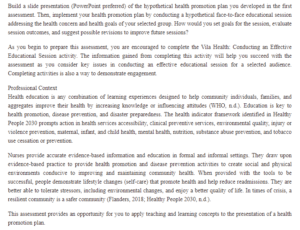
Health Promotion Plan
As you prepare this assessment, you are encouraged to complete the Vila Health: Conducting an Effective Educational Session activity. The information gained from completing this activity will help you succeed with the assessment as you consider critical issues in conducting a practical educational session for a selected audience. Completing activities is also a way to demonstrate engagement.
Professional Context
Health education is any combination of learning experiences designed to help community individuals, families, and aggregates improve their health by increasing knowledge or influencing attitudes (WHO, n.d.). Education is critical to health promotion, disease prevention, and disaster preparedness. The health indicator framework identified in Healthy People 2030 prompts action in health services accessibility, clinical preventive services, environmental quality, injury or violence prevention, maternal, infant, and child health, mental health, nutrition, substance abuse prevention, and tobacco use cessation or prevention.
Nurses provide accurate, evidence-based information and education in formal and informal settings. They draw upon evidence-based practice to provide health promotion and disease prevention activities to create social and physical environments conducive to improving and maintaining community health. When provided with the tools to be successful, people demonstrate lifestyle changes (self-care) that promote health and help reduce readmissions. They can better tolerate stressors, including environmental changes, and enjoy a better quality of life. In times of crisis, a resilient community is safer (Flanders, 2018; Healthy People 2030, n.d.).
This assessment allows you to apply teaching and learning concepts to a health promotion plan presentation.
Demonstration of Proficiency
By completing this assessment, you will demonstrate your proficiency in the following course competencies and assessment criteria:
Competency 3: Evaluate health policies based on their ability to achieve desired outcomes.
Evaluate educational session outcomes regarding progress made toward Healthy People 2030 objectives and leading health indicators.
Competency 4: Integrate principles of social justice in community health interventions.
Evaluate educational session outcomes and the attainment of agreed-upon health goals in collaboration with participants.
Competency 5: Apply professional, scholarly communication strategies to lead health promotion and improve population health.
Present a health promotion plan to an individual or group within a community.
Organize content with clear purpose/goals and relevant and evidence-based sources (published within five years).
Slides are easy to read and error-free. Detailed audio and speaker notes are provided. The audio is clear, organized, and professionally presented.
References
Flanders, S. A. (2018). Effective patient education: Evidence and common sense. Medsurg Nursing, 27(1), 5558.
U.S. Department of Health and Human Services, Office of Disease Prevention and Health Promotion. (n.d.). Healthy People 2030. https://health.gov/healthypeople
Note: This is the second part of a two-part assessment. You must complete Assessment 1 before completing this assessment.
Preparation
For this assessment, you will conclude the clinical learning activity you began in Assessment 1.
You will resume the community nurse role, addressing your community’s health concerns. This time, you will present, via educational outreach, the hypothetical health promotion plan you developed in Assessment 1 to your fictitious audience. In this hypothetical scenario, you will simulate the presentation as though it would be live and face-to-face. You must determine an effective teaching strategy, communicate the plan with professionalism and cultural sensitivity, evaluate the plan’s objectives, revise the plan as applicable, and propose improvements for future educational sessions. To engage your audience, you decide to develop a PowerPoint presentation with voice-over and speaker notes to communicate your plan.
Remember that your first assessment (Assessment 1) MUST be satisfactorily completed to initiate this assessment (Assessment 4).
Please review the assessment scoring guide for more information.
Complete the Vila Health: Conducting an Effective Educational Session simulation to prepare for the assessment. You may also review the health promotion plan presentation assessment and scoring guide to understand all requirements.

